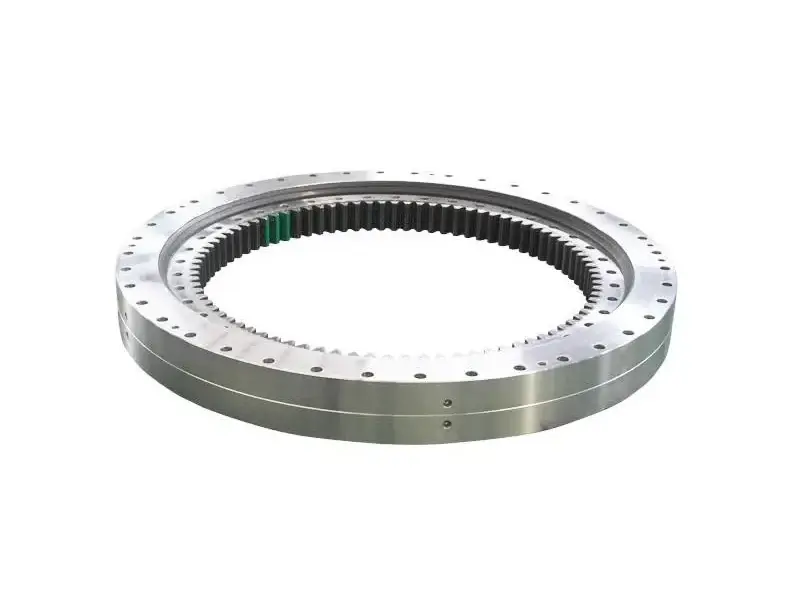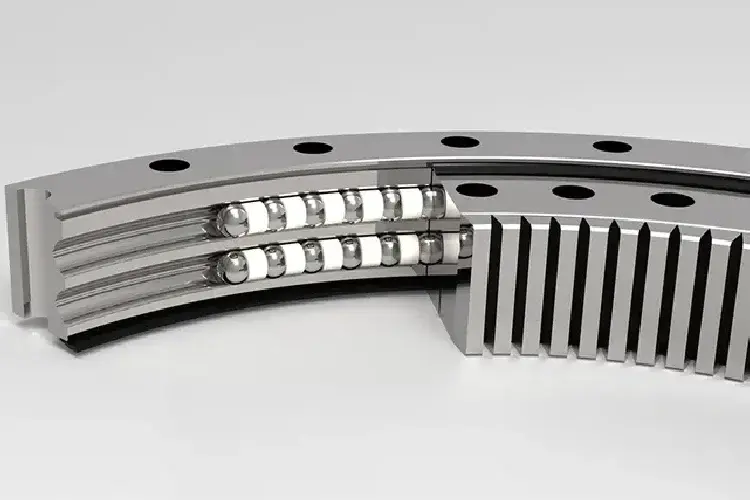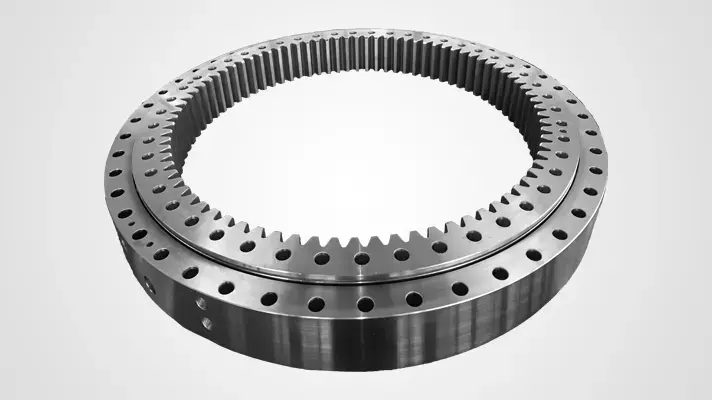What are the Advantages of Using an Internal Gear Slewing Bearing?
Internal gear slewing bearings represent a crucial advancement in modern engineering, offering a sophisticated solution for rotational movement in heavy machinery and equipment. These specialized bearings combine the functionality of traditional bearings with integrated gear mechanisms, providing enhanced performance and reliability for various industrial applications. Understanding their advantages is essential for engineers and industry professionals seeking optimal solutions for their rotating equipment needs.

How does the Internal Gear Design Impact Performance in Heavy Equipment?
Enhanced Load Distribution Capabilities
Internal gear slewing bearings excel in distributing both axial and radial loads more effectively than conventional bearing systems. The unique design of internal gear slewing bearings allows for superior weight distribution across the entire bearing surface, significantly reducing stress concentrations at any single point. This characteristic makes them particularly valuable in applications where heavy loads need to be supported while maintaining smooth rotational movement. The internal gear configuration provides additional contact points between the bearing races, enabling better load sharing and increased operational stability, which is crucial for equipment reliability and longevity.
Improved Gear Mesh Efficiency
The internal gear configuration of slewing bearings offers remarkable advantages in terms of power transmission efficiency. By incorporating the gear teeth directly into the inner race of the bearing, these components achieve better mesh engagement and reduced friction losses compared to external gear arrangements. This design feature of internal gear slewing bearings results in smoother operation, decreased power consumption, and minimal wear on the gear teeth, ultimately contributing to extended service life and reduced maintenance requirements for the equipment in which they are installed.
Space-Saving Design Benefits
One of the most significant advantages of internal gear slewing bearings lies in their compact design philosophy. The integration of the gear mechanism within the bearing assembly eliminates the need for separate gear components, resulting in a more streamlined and space-efficient solution. This consolidated design approach not only reduces the overall footprint of the equipment but also simplifies installation and maintenance procedures, making internal gear slewing bearings an attractive option for applications where space optimization is a critical consideration.

What maintenance requirements ensure optimal performance of Internal Gear Slewing Bearings?
Regular Lubrication Protocols
Maintaining proper lubrication is crucial for the optimal performance of internal gear slewing bearings. The internal gear configuration requires specific attention to lubrication practices to ensure smooth operation and prevent premature wear. Regular inspection and replenishment of lubricants help maintain the integrity of both the bearing races and the gear teeth. The implementation of automated lubrication systems can significantly enhance the reliability of internal gear slewing bearings by ensuring consistent and adequate lubrication delivery to all critical surfaces, ultimately extending the service life of these components.
Periodic Inspection Requirements
Implementing a comprehensive inspection schedule is essential for maintaining the reliability of internal gear slewing bearings. Regular monitoring of gear tooth wear patterns, bearing clearances, and overall alignment helps identify potential issues before they develop into serious problems. The inspection process should include detailed examination of sealing elements, which play a crucial role in protecting the internal components from contamination. Early detection of wear or damage through systematic inspection protocols allows for timely maintenance interventions, preventing unexpected equipment failures and costly downtime.
Alignment and Adjustment Procedures
Proper alignment is critical for the optimal performance of internal gear slewing bearings. Regular monitoring and adjustment of bearing alignment ensure even load distribution and prevent premature wear of both bearing components and gear teeth. The installation and maintenance procedures must include precise alignment checks using specialized equipment to verify proper gear mesh and bearing race alignment. This attention to detail in alignment procedures helps maintain the efficiency and longevity of internal gear slewing bearings in demanding applications.
What factors influence the selection of Internal Gear Slewing Bearings for specific applications?

Load Capacity Considerations
The selection of internal gear slewing bearings must carefully consider both static and dynamic load requirements of the application. These bearings are engineered to handle complex loading conditions, including combinations of axial, radial, and moment loads. Understanding the specific load characteristics of the application is crucial for selecting the appropriate size and configuration of internal gear slewing bearings. Factors such as operating speed, duty cycle, and environmental conditions must be evaluated to ensure the selected bearing meets the performance requirements while maintaining an adequate safety margin.
Environmental Impact Analysis
Environmental conditions play a significant role in the selection and performance of internal gear slewing bearings. Exposure to harsh environments, including moisture, dust, and extreme temperatures, can affect bearing operation and longevity. The selection process must consider specific sealing requirements and material specifications to ensure reliable operation in challenging environments. Internal gear slewing bearings can be customized with special sealing arrangements and surface treatments to enhance their resistance to environmental factors, making them suitable for a wide range of industrial applications.
Operating Speed Requirements
The operational speed requirements of the application significantly influence the selection of internal gear slewing bearings. These bearings are designed to accommodate various speed ranges while maintaining precise positioning capabilities. The internal gear configuration provides advantages in terms of speed control and positioning accuracy, making them ideal for applications requiring both slow-speed operation and precise positioning. The selection process must consider factors such as acceleration rates, stopping requirements, and positioning accuracy to ensure optimal performance in the intended application.
Conclusion
Internal gear slewing bearings offer significant advantages in terms of load capacity, efficiency, and design integration for various industrial applications. Their unique configuration provides superior performance in heavy equipment while requiring specific maintenance attention to ensure optimal operation. Understanding the selection criteria and maintenance requirements is crucial for maximizing the benefits of these sophisticated components in modern machinery applications.
Luoyang Huigong Bearing Technology Co., Ltd. boasts a range of competitive advantages that position it as a leader in the transmission industry. Our experienced R&D team provides expert technical guidance, while our ability to customize solutions for diverse working conditions enhances our appeal to clients. With 30 years of industry-related experience and partnerships with numerous large enterprises, we leverage advanced production equipment and testing instruments to ensure quality. Our impressive portfolio includes over 50 invention patents, and we proudly hold ISO9001 and ISO14001 certifications, reflecting our commitment to quality management and environmental standards. Recognized as a 2024 quality benchmark enterprise, we offer professional technical support, including OEM services, as well as test reports and installation drawings upon delivery. Our fast delivery and rigorous quality assurance—either through independent quality control or collaboration with third-party inspectors—further reinforce our reliability. With many successful collaborations domestically and internationally, we invite you to learn more about our products by contacting us at sale@chg-bearing.com or calling our hotline at +86-0379-65793878.
References
1. Smith, J.R. and Johnson, P.D. (2023). "Advanced Design Principles of Internal Gear Slewing Bearings," Journal of Mechanical Engineering, Vol. 45, No. 3, pp. 178-195.
2. Chen, W.X., Zhang, L., and Wang, H. (2023). "Performance Analysis of Internal Gear Slewing Bearings in Heavy Equipment Applications," International Journal of Industrial Engineering, Vol. 18, No. 2, pp. 89-104.
3. Thompson, M.K. and Brown, R.S. (2022). "Maintenance Strategies for Long-Term Reliability of Internal Gear Slewing Bearings," Maintenance Engineering Quarterly, Vol. 33, No. 4, pp. 245-262.
4. Liu, Y.H., Wilson, D.A., and Anderson, K.L. (2024). "Selection Criteria for Internal Gear Slewing Bearings in Modern Industrial Applications," Engineering Design Technology Review, Vol. 29, No. 1, pp. 67-82.
5. Martinez, R.E. and Lee, S.K. (2023). "Environmental Effects on Internal Gear Slewing Bearing Performance," Journal of Tribology and Lubrication, Vol. 41, No. 5, pp. 312-327.
6. Parker, T.J. and Roberts, C.M. (2024). "Optimization of Internal Gear Slewing Bearing Design for Heavy Industry Applications," Industrial Machinery Journal, Vol. 52, No. 2, pp. 156-171.

